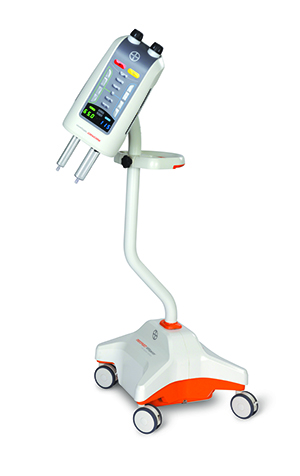Researchers Develop Nanoparticle-based MRI Contrast Agent
 A team of researchers have developed a high-performance, nanoparticle-based MRI contrast agent, SAIO (Supramolecular Amorphous-like Iron Oxide), for 3D vascular mapping. The particle is 5 nanometers in size, which is about 1,500 times smaller than the microvascular diameter and therefore can circulate across blood vessels in the body. The research, led by Professor Cheon Jinwoo, the director of the Center for Nanomedicine (CNM), Institute for Basic Science (IBS) at Yonsei University, Seoul, South Korea and Professor Choi Byoung Wook from Yonsei University College of Medicine, was published online in Nature Biomedical Engineering.
A team of researchers have developed a high-performance, nanoparticle-based MRI contrast agent, SAIO (Supramolecular Amorphous-like Iron Oxide), for 3D vascular mapping. The particle is 5 nanometers in size, which is about 1,500 times smaller than the microvascular diameter and therefore can circulate across blood vessels in the body. The research, led by Professor Cheon Jinwoo, the director of the Center for Nanomedicine (CNM), Institute for Basic Science (IBS) at Yonsei University, Seoul, South Korea and Professor Choi Byoung Wook from Yonsei University College of Medicine, was published online in Nature Biomedical Engineering.
The SAIO is a special nanoparticle that consist of a polysaccharide core made primarily with dextran cross-linked with other molecules. This core is then coated with an iron oxide surface to give it paramagnetic properties at room temperature. The hybrid nature of the SAIOs gives them both excellent biocompatibility and imaging performance. The researchers compared the contrast performance, retention, and renal clearance profile of the SAIO against Dotarem (a gadolinium-based agent) and iron oxide nanoparticles.
“SAIO is expected to play a vital role in increasing the accuracy of the diagnosis of cerebro-cardiovascular diseases such as stroke, myocardial infarction, angina, and dementia," says Professor Wook.
Professor Jinwoo adds, "SAIO is a next-generation contrast agent that satisfies both high resolution and safety at the same time."
SAIO is a high-resolution imaging agent, reportedly 10 times more precise than the image generated using current contrast agents. It has achieved a 3D brain vascular mapping that can clearly identify brain microvessels as thin as a hair (100 microns) in animal experiments. In addition to excellent resolution, the enhancement lasts substantially longer (>10 min) in comparison to Dotarem (< 2 min), which gives the radiologist an ample amount of time to carry out the imaging procedures. These excellent properties of the SAIO allowed the researchers to observe the heart blood vessels, which are hardly visible with current MRI contrast agents.
In addition to having high resolution, excretion of the contrasting agent through urine is especially important to avoid its accumulation within the body, which can cause various side effects. SAIO has an excellent renal clearance profile without accumulation in liver or spleen. It was also found that SAIO was stable without aggregation nor iron leaching for up to a year.
Related Articles
Citation
Researchers Develop Nanoparticle-based MRI Contrast Agent. Appl Radiol.
March 12, 2021